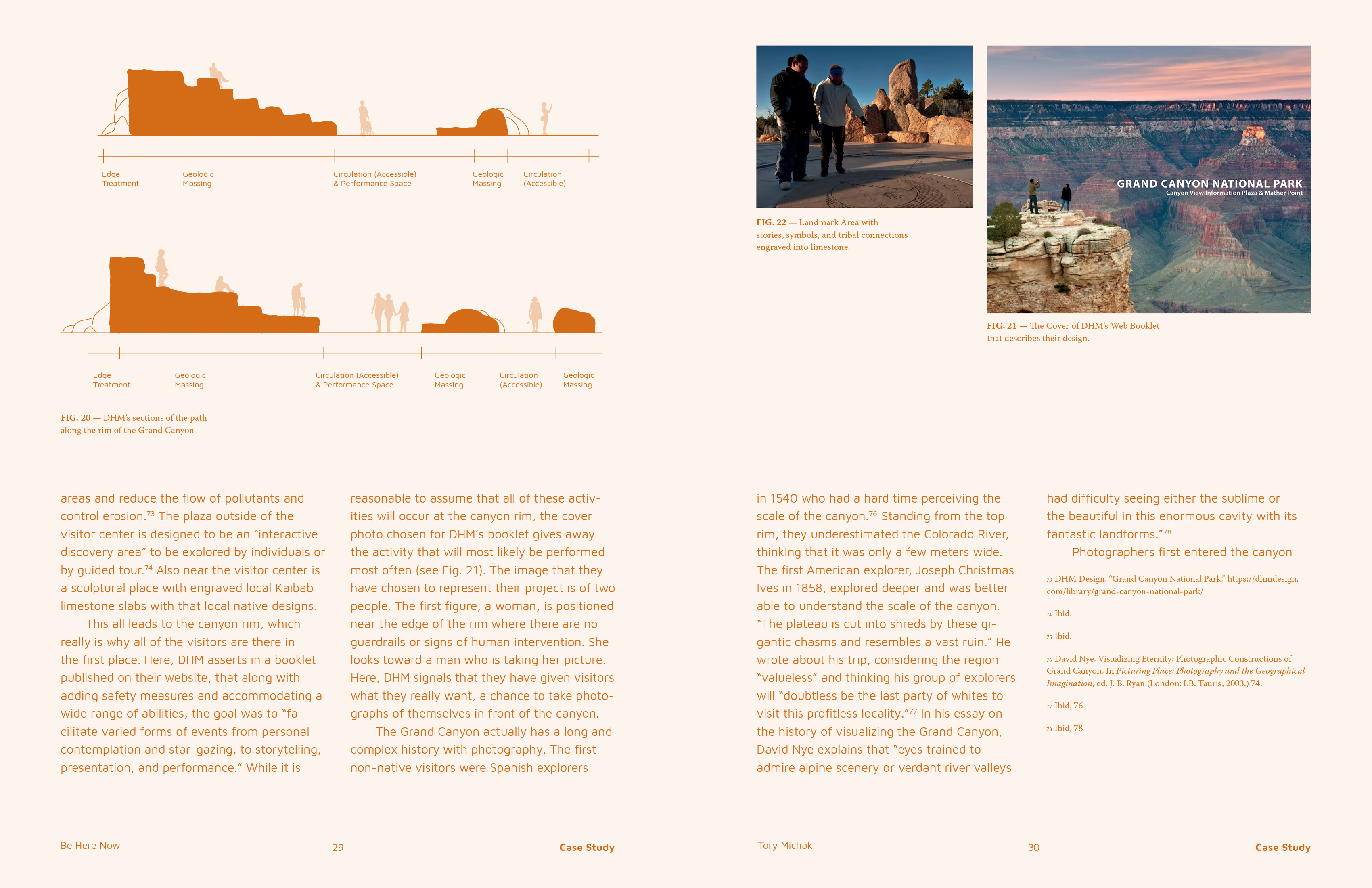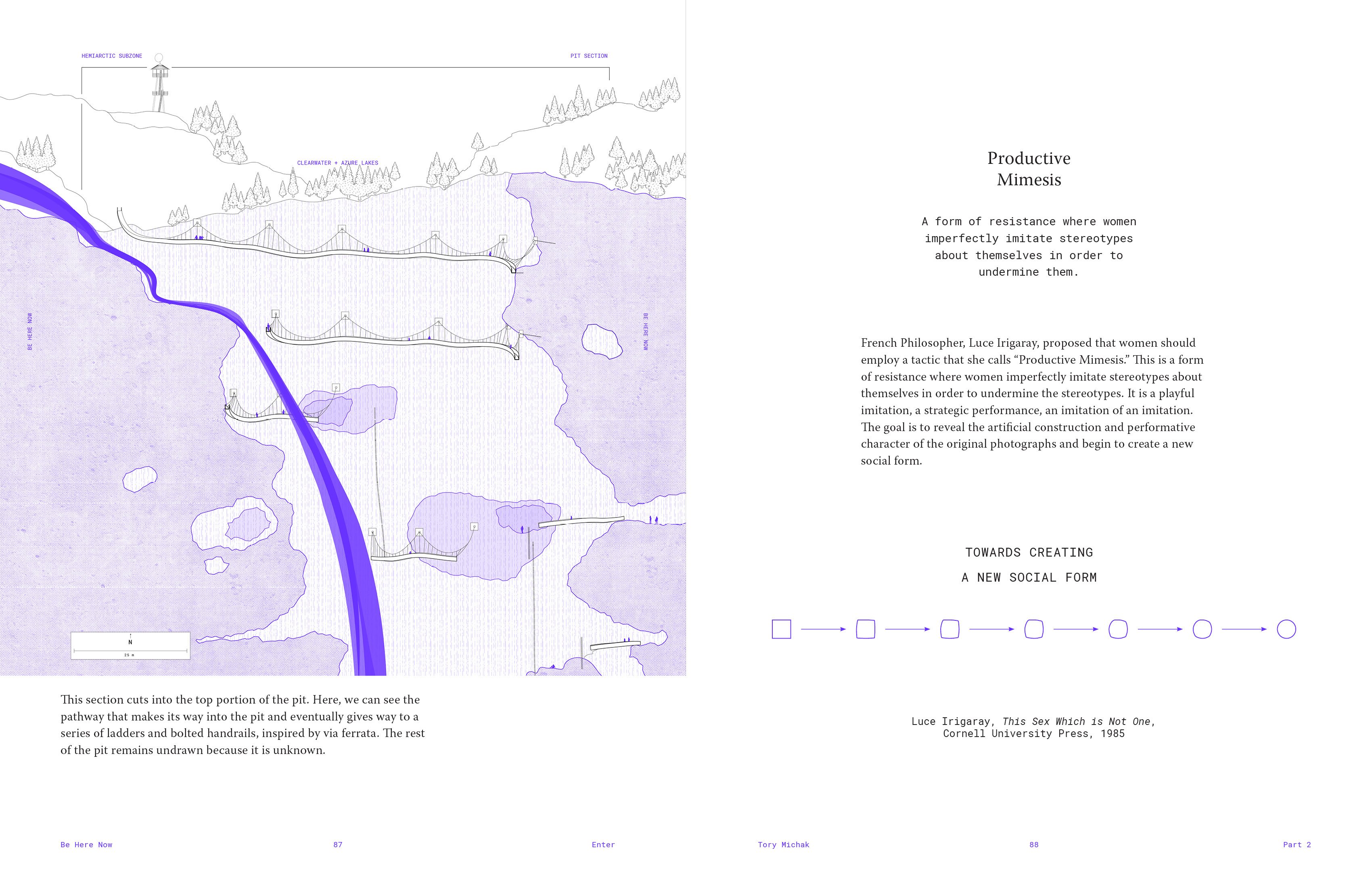Be Here Now:
Instagram and the Feminization of Wilderness
In less than a decade of existence, Instagram has changed the way we interact with wilderness. From online oversharing to site overuse, social media is often considered “too much,” something that needs escaping from in order to get back to our true selves. In the Western world, wilderness has always been that somewhere to escape. But wilderness ideology has a problematic history of exclusion. Instagram is adding to the complexity of wilderness and diversifying who gets to experience and define wilderness.
Through adding digital layers of representation and discourse, those traditionally erased or misrepresented are choosing how to represent themselves.
This thesis, sited in an already viral landscape, imagines a place where technology and wilderness will coexist, where wilderness is not a place to escape the internet, and where relationships between the self and others are reconfigured.
Through adding digital layers of representation and discourse, those traditionally erased or misrepresented are choosing how to represent themselves.
This thesis, sited in an already viral landscape, imagines a place where technology and wilderness will coexist, where wilderness is not a place to escape the internet, and where relationships between the self and others are reconfigured.
graduate project, spring 2019
Daniel Roehr, Susan Herrington
faculty advisor
David Zielnicki
in the news
The Tyee
Daniel Roehr, Susan Herrington
faculty advisor
David Zielnicki
in the news
The Tyee
Part 1: Research
The research portion of this graduate project set out to examine the popularity of outdoor recreation photos on Instagram. I wanted to know how Instagram was changing so-called wilderness landscapes and what could be done to manage the crowding and behavioural issues that can partially be attributed to some places going viral on Instagram.
Two very different precedents were used to look at how some spaces were highly influenced by Instagram culture: pop-up Instagram experiences and Mather Point in the Grand Canyon, recently redesigned by DHM Design.
My research then turned to look at the motivations for those who post their outdoor recreation photos on Instagram (more than a billion people overall use the platform regularly). After compiling, organizing, and overlaying Instagram photos that had been geotagged to the Stawamus Chief in Squamish, BC, I found that women had a much larger presence in this outdoor area on Instagram than their presence in the physical location. I theorized that women and other groups that have been long erased from wilderness recreation are using Instagram to assert their presence in wilderness areas, changing our conception of wilderness and enabling women to represent themselves however they wish.





















Part 2: Design Response
This journey takes place in the rarely visited mountainous Northern region of Wells Gray Provincial Park, in Eastern BC. The park’s branding, calling itself “the Canada you imagined” taps into our conception of wilderness as a place untouched but open and ready to be explored or to be conquered. In this case, the “conquering” is done by recreating. The pit at the center of the journey has been known by humans since the Wells Gray area was a valued hunting ground for the Simpcw, Chilcotin, and Canim Lake First Nations. But the pit was recently “rediscovered” by biologists during a helicopter caribou survey last spring.
This project imagines the journies that will be taken to this viral pit. Along the way, technology use is encouraged by "tech packs” which offer electricity, wifi, and lighting, but there will inevitably be periods of “disconnecting” as well. Throughout the journey, we continue to explore wilderness and self-representation. Do we have an obligation to share photos that are better represent our true experiences? What even is an authentic photo?
This project is inspired by Donna Haraway’s Cyborg Theory. The cyborg is a theory appropriated from the military and it allows us to explore alternative ways of being human. Through the cyborg, we can explore more fluid identities and break down boundaries. The theory is playful in that it is an argument for taking pleasure in the blurring the boundaries. But is also responsible. It is a call for being responsible for the representations of ourselves that we generate.





















French Philosopher, Luce Irigaray, proposed that women should employ a tactic that she calls “Productive Mimesis.” This is a form of resistance where women imperfectly imitate stereotypes about themselves in order to undermine the stereotypes. It is a playful imitation, a strategic performance, an imitation of an imitation.
The goal is to reveal the artificial construction and performative character of the original photographs and begin to create a new social form.
I paired a list of stereotypes with women, technology, and nature with photo techniques from the British Columbia Brand Book and applied them to photos from Wells Gray to create filters, or “Productive Memes.”
The goal is to reveal the artificial construction and performative character of the original photographs and begin to create a new social form.
I paired a list of stereotypes with women, technology, and nature with photo techniques from the British Columbia Brand Book and applied them to photos from Wells Gray to create filters, or “Productive Memes.”







